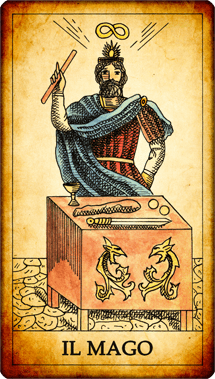Probably originating, as already mentioned, from the "naibi", the major arcana of the tarot retain their strongly allegorical character. The letters, the images, and the numbers that distinguish them, connect them, running along the tracks of analogy, in the sky with stars and planets, on the earth with the obligatory steps, the choices, the tests, the typical situations of existence.
Starting from the representation of each blade, analyzed in colors and details, a whole skein of meanings unfolds. But, unfortunately, at the expense of clarity and simplicity, we are not dealing with rigidly classifiable meanings, capable of making the arcane, according to an exquisitely Manichaean perspective, good or bad.
As, according to the subtle philosophies of the East, nothing in the universe can be defined absolutely positive or negative, the ultimate meaning of the arcane is modeled on the peculiar situation of the consultant in relation to the direction of the card, the position occupied in the game, the relationships with neighboring blades.

Every manual of cartomancy and even this does not escape the rule, tends to provide for each blade a series of preconceived meanings, scaffolding on which to support the interpretation. Through the practice of meditation on the single arcane and above all constant divination, carried out for self-study purposes, the dependence on pre-packaged schemes will in any case weaken. Then that leap in quality will have been made, that plunge into the archetype that allows you to grasp, at least for the few minutes necessary for interpretation, the perpetual fluidity of the mystery, the subtle game of influences by which it dyes the neighboring cards. and in turn, it assumes its coloring.
Unless otherwise specified, this site has therefore preferred to group the symbolic definitions of the individual blades under the generic classification of positive or negative, not to be confused for any reason with the reverse, right, or reverse.
In fact, if in most cases, for the cards defined as "good" the upside-down side determines an attenuation of the benignity or even a polarity inversion, the blades considered negative, such as the Devil, the Tower, the Moon, the Hanged Man, they benefit from this reversal, taking on a more rosy, lighter shade. Similarly, a favorable blade placed in the opposite position, let us put on the side of the game destined to difficulties, absorbs its negative content, losing much of its kindness, just as a "difficult" card surrounded by beneficial "sisters" cancels or at least limits its own ominous omens.
Daily experience, however burdensome, teaches with a subtle and continuous lesson, supported also by the great philosophical systems, how much today's evil can, already tomorrow, reveal a preparatory function for good and how much the good we believe we possess can reveal itself, already tomorrow, a soap bubble. The ordered series of the 22 major arcana seems to constitute the graphic and symbolic realization of this system of thought. From the Magician to the Fool, all the crucial points of existence are summarized in an initiatory journey that, starting from creation, reaches, through the succession of various stages of knowledge, temptations, falls, and overcoming the world of perfection.



